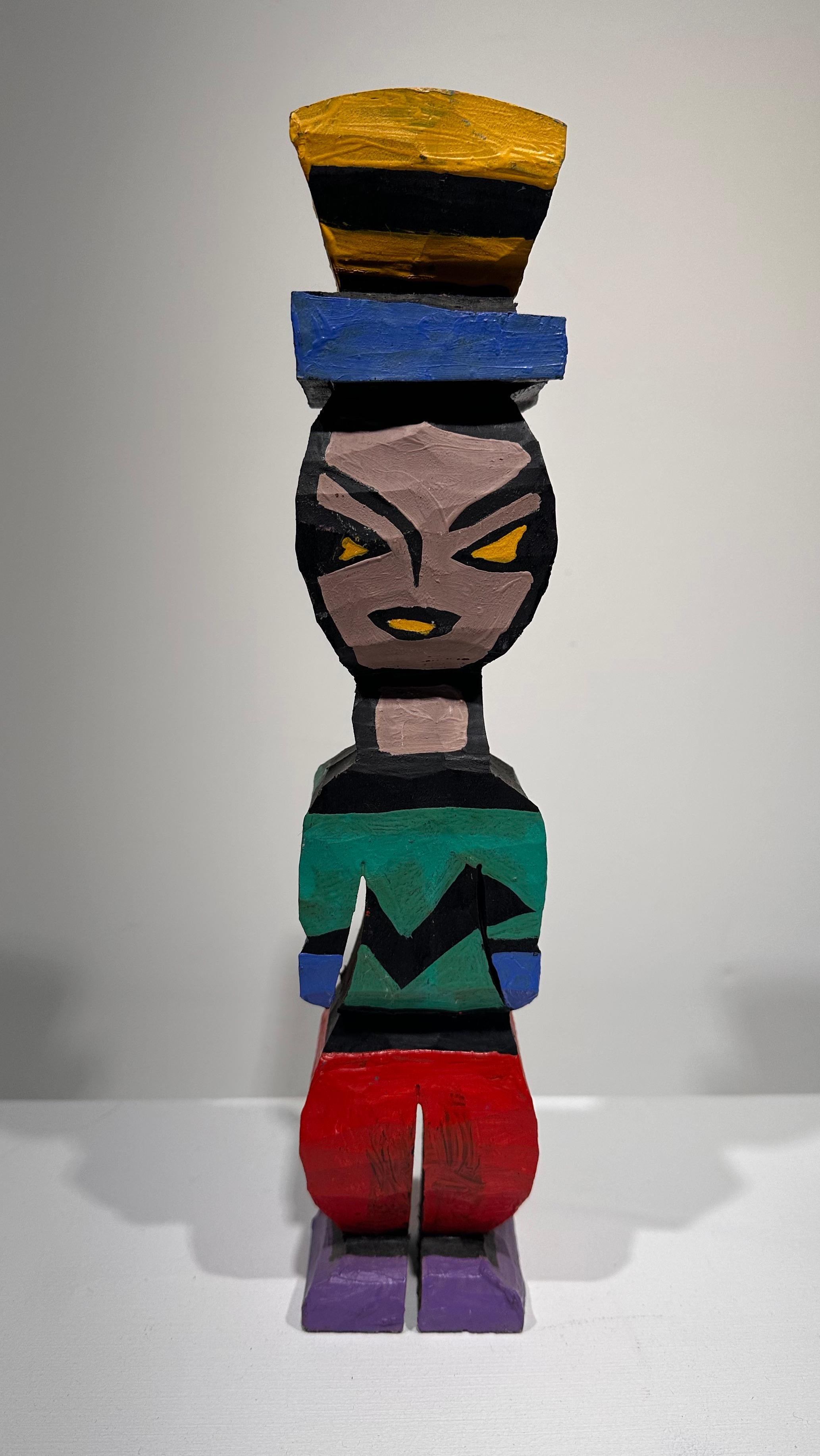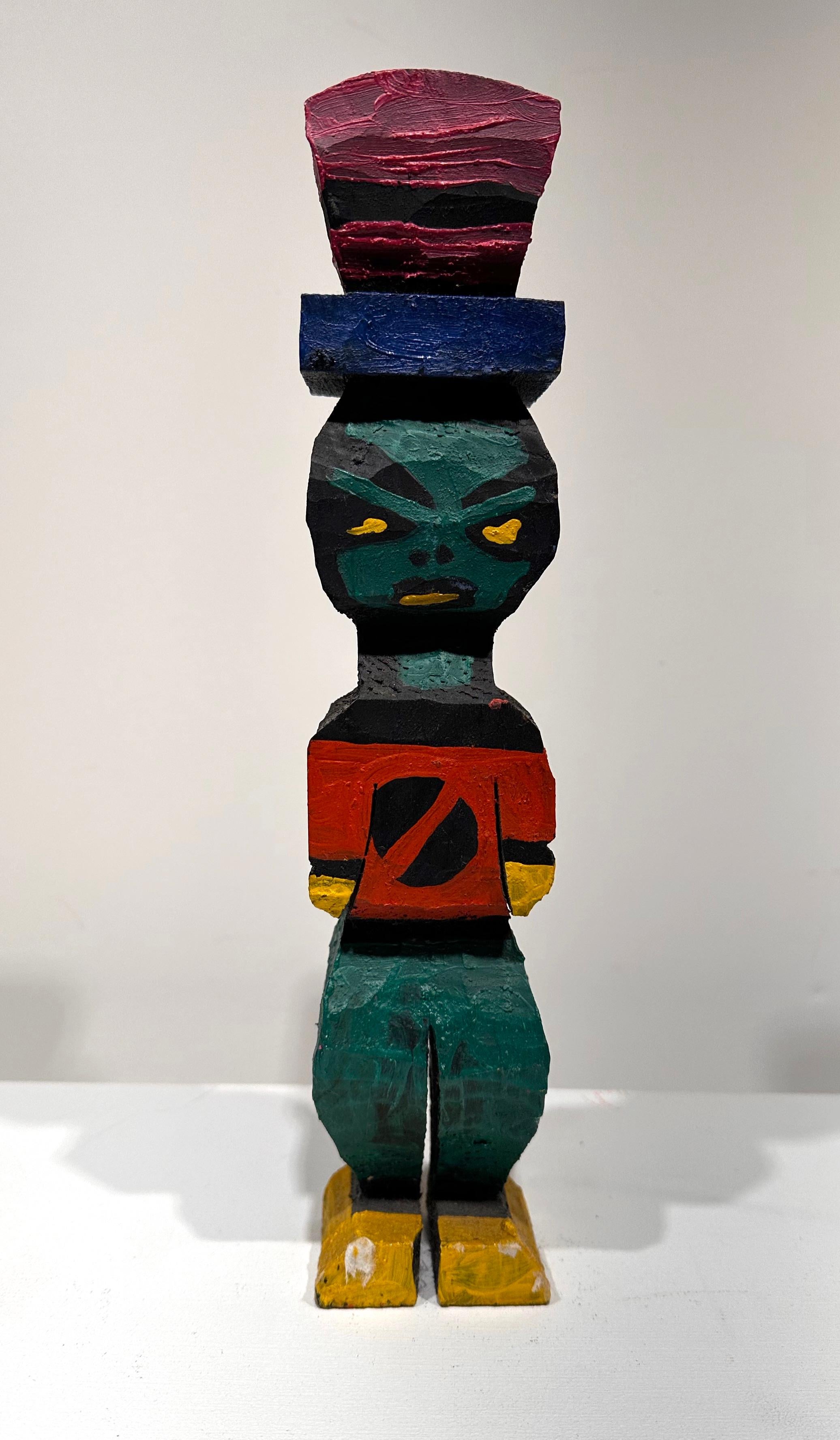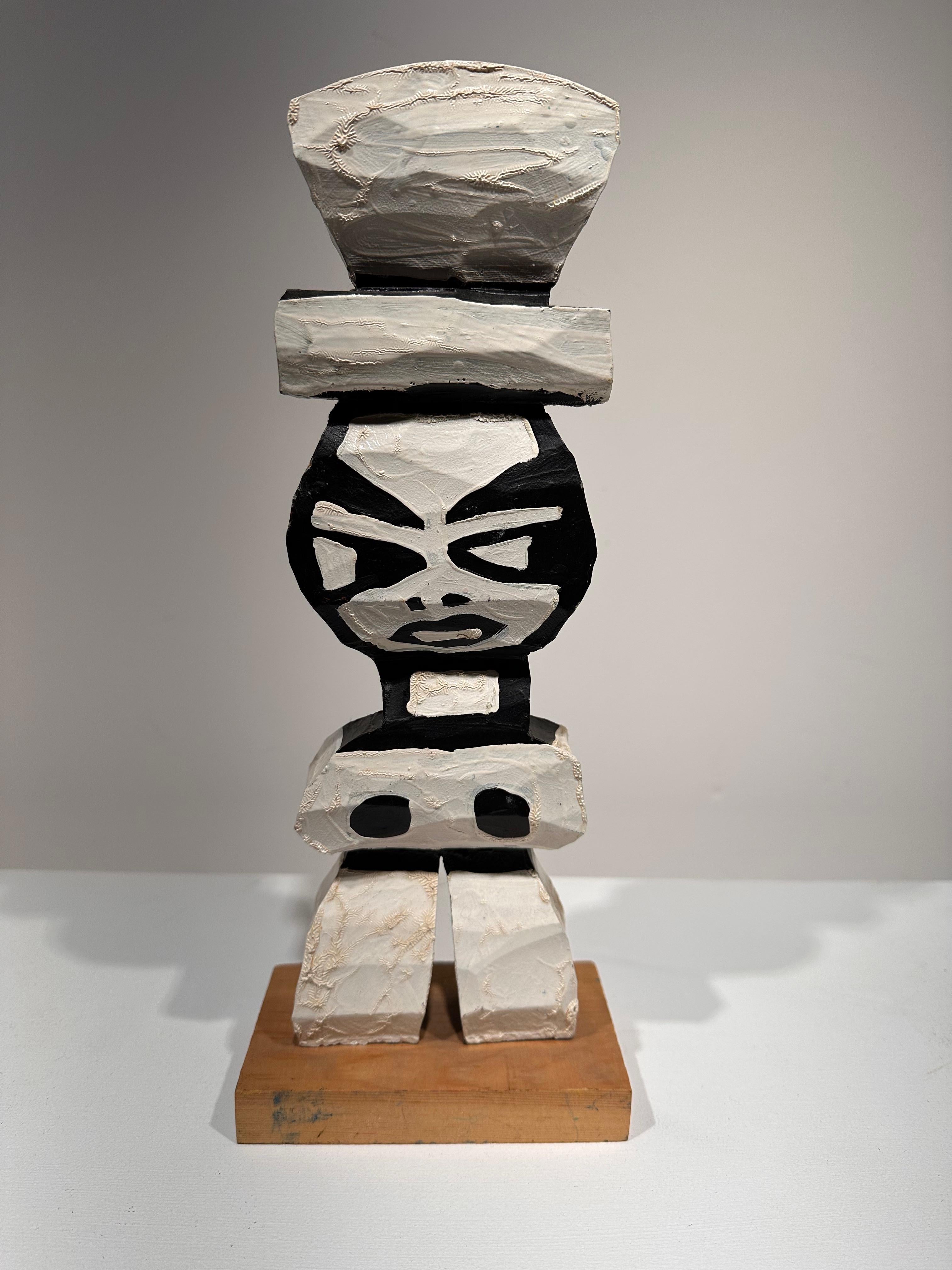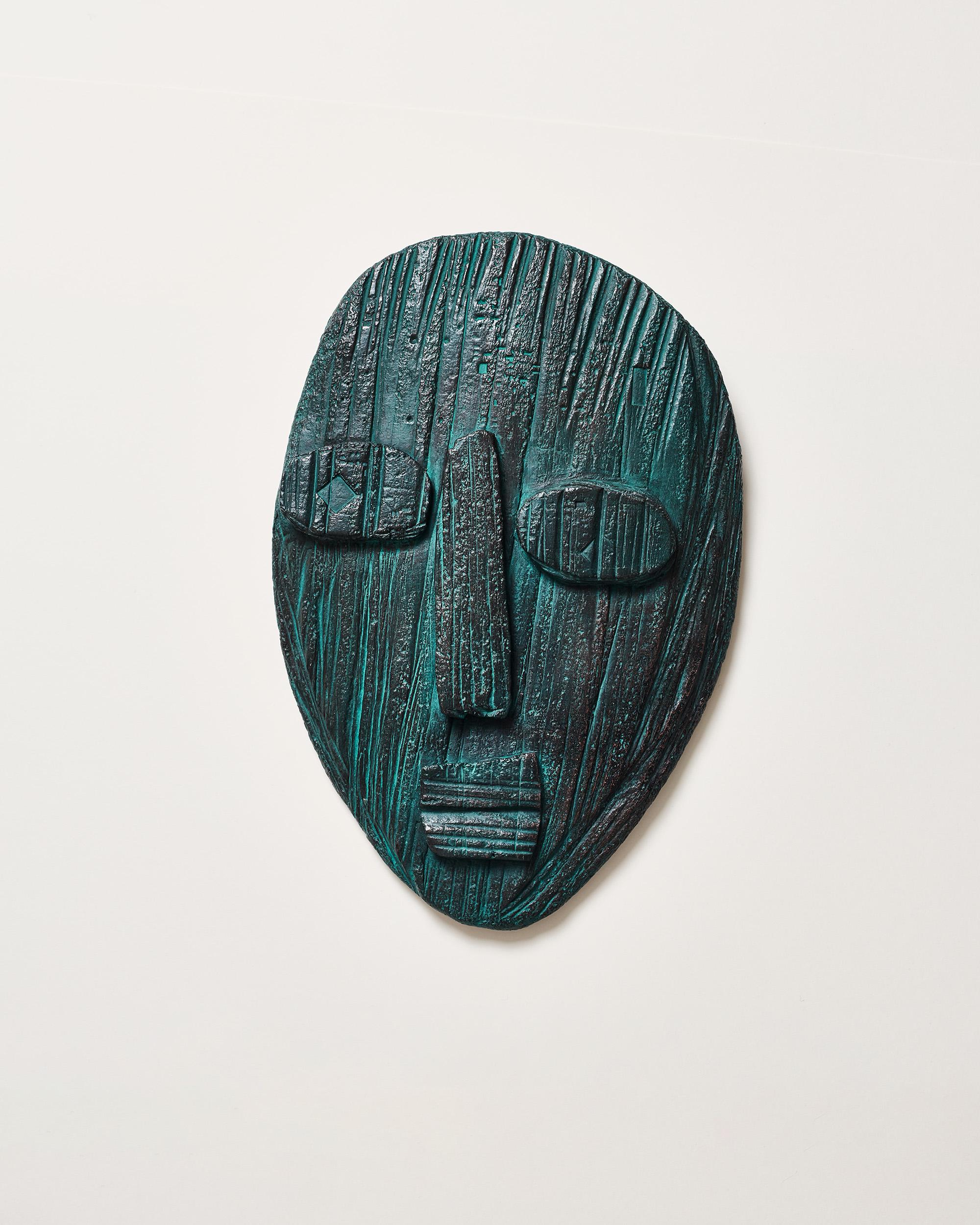Items Similar to Standing Figure
Want more images or videos?
Request additional images or videos from the seller
1 of 6
Tom CramerStanding Figure1998
1998
About the Item
Tom Cramer (b.1960). Standing Figure, 1998. Carved wood and polymer paint. Measures 17.5 inches high. Excellent condition. Signed and dated under base.
Tom Cramer is an American artist working in Portland, Oregon noted for his intricately carved and painted wood reliefs and ubiquity throughout the city of Portland. Often called the unofficial Artist Laureate of Portland,[2] Cramer is one of the most visible and successful artists in the city. The influences on his work are both organic and technological. He is widely collected and is in many prominent west coast museum and private collections. He is in the permanent collections of the Portland Art Museum[3] in Portland Oregon, the Halle Ford Museum in Salem Oregon, the Jordan Schnitzer Museum in Eugene, Oregon, the Boise Art Museum in Idaho.
Cramer made a name for himself in the 1980s and 1990s becoming a bridge between historical Oregon artists like Clifford Gleason and Milton Wilson and the international influx of new artists to the city since the mid-1990s. Tom Cramer grew up in Portland, Oregon in a musical family and played French horn in the Portland Youth Philharmonic in the late 1970s. He first started drawing in 1973 during this period and gradually became more interested in visual art. His first serious art classes in high school were followed by later instruction at the Museum Art School (later called the Pacific NW College of Art) in Portland, Oregon as well as Pratt Institute in New York. Cramer went to the same high school as Gus Van Sant and appeared briefly in his feature film My Own Private Idaho. A Cramer painted VW Van appeared in Van Sant’s Even Cowgirls Get the Blues. While in New York - Cramer encountered the likes of many artists including Keith Haring, Jean-Michel Basquiat, Mike Bidlo, Kent Floeter. The Primitive/Modern show and High/Low shows had special influence as did the burgeoning East Village art scene. Cramer returned to Portland, Oregon in the mid-1980s and quickly became well known via many shows at the Folkcraft Gallery and later the Jamison Thomas Gallery. There he expanded his show base to Los Angeles and San Francisco - as well as the Jamison Thomas Gallery in New York. He later had one person shows at the Blue Gallery, the Butters Gallery, the Pulliam Gallery as well as the Mark Woolley Gallery. From 2006 - 2013, he was with the Laura Russo Gallery. Currently he is represented by The Augen Gallery in Portland and the Imogen Gallery in Astoria. A show of carved wood reliefs and drawings for the Jordan Schnitzer Museum of Art took place in Fall 2019. Tom Cramer has always been heavily influenced by classical as well as modern popular music. He has cited an improvisational approach to his creative process that is not unlike a musical approach. Key musical influences include Bach, Beethoven, Bruckner, Klaus Schulze, Future Sound of London and Miles Davis. He became well known in the 1980s and 1990s for his painted cars as well as large scale colorful murals. He later designed costumes and sets for James Canfield's, "Jungle" with a soundtrack by the Future Sound of London. In the 1980s, he began his painted and carved wood reliefs which became his most noteworthy works. He also does carved/painted furniture and objects, as well as continuing his work in drawing and oil painting. His best known mural, "Machine", from 1989 was demolished in 2017. However, he has recently been doing a series of new murals around Portland, Oregon. Several recent trips to India, Egypt and Europe have expanded his base of influences.
Tom Cramer continues to work in a variety of media - including drawing, painted relief carving, murals and oil on canvas paintings.
- Creator:Tom Cramer (1960, American)
- Creation Year:1998
- Dimensions:Height: 17.25 in (43.82 cm)Width: 6 in (15.24 cm)Depth: 2.5 in (6.35 cm)
- Medium:
- Movement & Style:
- Period:
- Condition:
- Gallery Location:Wilton Manors, FL
- Reference Number:1stDibs: LU245211959032
About the Seller
4.9
Gold Seller
These expertly vetted sellers are highly rated and consistently exceed customer expectations.
Established in 2007
1stDibs seller since 2015
327 sales on 1stDibs
Typical response time: 10 hours
- ShippingRetrieving quote...Ships From: Wilton Manors, FL
- Return PolicyA return for this item may be initiated within 7 days of delivery.
More From This SellerView All
- Standing FigureLocated in Wilton Manors, FLTom Cramer (b.1960). Standing Figure, 1980. Carved wood and polymer paint. Measures 11.5 inches high. Excellent condition. Signed and dated under base. Tom Cramer is an American artist working in Portland, Oregon noted for his intricately carved and painted wood reliefs and ubiquity throughout the city of Portland. Often called the unofficial Artist Laureate of Portland,[2] Cramer is one of the most visible and successful artists in the city. The influences on his work are both organic and technological. He is widely collected and is in many prominent west coast museum and private collections. He is in the permanent collections of the Portland Art Museum[3] in Portland Oregon, the Halle Ford Museum in Salem Oregon, the Jordan Schnitzer Museum in Eugene, Oregon, the Boise Art Museum in Idaho. Cramer made a name for himself in the 1980s and 1990s becoming a bridge between historical Oregon artists like Clifford Gleason and Milton Wilson...Category
Late 20th Century Neo-Expressionist Figurative Sculptures
MaterialsWood, Latex
- Standing FigureLocated in Wilton Manors, FLTom Cramer (b.1960). Standing Figure, 1988. Carved wood and polymer paint. Measures 11.5 inches high. Excellent condition. Signed and dated under base. Tom Cramer is an American artist working in Portland, Oregon noted for his intricately carved and painted wood reliefs and ubiquity throughout the city of Portland. Often called the unofficial Artist Laureate of Portland,[2] Cramer is one of the most visible and successful artists in the city. The influences on his work are both organic and technological. He is widely collected and is in many prominent west coast museum and private collections. He is in the permanent collections of the Portland Art Museum[3] in Portland Oregon, the Halle Ford Museum in Salem Oregon, the Jordan Schnitzer Museum in Eugene, Oregon, the Boise Art Museum in Idaho. Cramer made a name for himself in the 1980s and 1990s becoming a bridge between historical Oregon artists like Clifford Gleason and Milton Wilson...Category
Late 20th Century Neo-Expressionist Figurative Sculptures
MaterialsWood, Latex
- Standing FigureLocated in Wilton Manors, FLTom Cramer (b.1960). Standing Figure, 1998. Carved wood and polymer paint. Measures 10.25 inches high. Excellent condition. Signed and dated under base. Tom Cramer is an American artist working in Portland, Oregon noted for his intricately carved and painted wood reliefs and ubiquity throughout the city of Portland. Often called the unofficial Artist Laureate of Portland,[2] Cramer is one of the most visible and successful artists in the city. The influences on his work are both organic and technological. He is widely collected and is in many prominent west coast museum and private collections. He is in the permanent collections of the Portland Art Museum[3] in Portland Oregon, the Halle Ford Museum in Salem Oregon, the Jordan Schnitzer Museum in Eugene, Oregon, the Boise Art Museum in Idaho. Cramer made a name for himself in the 1980s and 1990s becoming a bridge between historical Oregon artists like Clifford Gleason and Milton Wilson...Category
Late 20th Century Neo-Expressionist Figurative Sculptures
MaterialsWood, Latex
- Standing FigureLocated in Wilton Manors, FLTom Cramer (b.1960). Standing Figure, 1998. Carved wood and polymer paint. Measures 12 inches high. Excellent condition. Signed and dated under base. Tom Cramer is an American artist working in Portland, Oregon noted for his intricately carved and painted wood reliefs and ubiquity throughout the city of Portland. Often called the unofficial Artist Laureate of Portland,[2] Cramer is one of the most visible and successful artists in the city. The influences on his work are both organic and technological. He is widely collected and is in many prominent west coast museum and private collections. He is in the permanent collections of the Portland Art Museum[3] in Portland Oregon, the Halle Ford Museum in Salem Oregon, the Jordan Schnitzer Museum in Eugene, Oregon, the Boise Art Museum in Idaho. Cramer made a name for himself in the 1980s and 1990s becoming a bridge between historical Oregon artists like Clifford Gleason and Milton Wilson...Category
Late 20th Century Neo-Expressionist Figurative Sculptures
MaterialsLatex, Wood
- Abstract FigureBy Raul DiazLocated in Wilton Manors, FLRaul Diaz (Argentina, b.1950). Abstract Figure, ca. 1970s. Canved Walnut. Measures 17 inches tall including wood base. Carved signature in lower region. Excellent condition. An ear...Category
1970s Abstract Expressionist Abstract Sculptures
MaterialsWalnut
- Reclining Figure (woman)By William King (b.1925)Located in Wilton Manors, FLWilliam King (1925-2015). Reclining figure, ca. 1965. Cast and welded bronze, 7 x 9.5 x 5 inches. Unsigned. William King, a sculptor in a variety of materials whose human figures traced social attitudes through the last half of the 20th century, often poking sly and poignant fun at human follies and foibles, died on March 4 at his home in East Hampton, N.Y. He was 90. His death was confirmed by Scott Chaskey, who is married to Mr. King's stepdaughter, Megan Chaskey. Mr. King worked in clay, wood, bronze, vinyl, burlap and aluminum. He worked both big and small, from busts and toylike figures to large public art pieces depicting familiar human poses -- a seated, cross-legged man reading; a Western couple (he in a cowboy hat, she in a long dress) holding hands; a tall man reaching down to tug along a recalcitrant little boy; a crowd of robotic-looking men walking in lock step. But for all its variation, what unified his work was a wry observer's arched eyebrow, the pointed humor and witty rue of a fatalist. His figurative sculptures, often with long, spidery legs and an outlandishly skewed ratio of torso to appendages, use gestures and posture to suggest attitude and illustrate his own amusement with the unwieldiness of human physical equipment. His subjects included tennis players and gymnasts, dancers and musicians, and he managed to show appreciation of their physical gifts and comic delight at their contortions and costumery. His suit-wearing businessmen often appeared haughty or pompous; his other men could seem timid or perplexed or awkward. Oddly, or perhaps tellingly, he tended to depict women more reverentially, though in his portrayals of couples the fragility and tender comedy inherent in couplehood settled equally on both partners. Mr. King's work is in the collections of the Metropolitan Museum of Art and the Museum of Modern Art in New York and the Smithsonian American Art Museum in Washington, among other places, and he had dozens of solo gallery shows in New York and elsewhere. But the comic element of his work probably caused his reputation to suffer. Reviews of his exhibitions frequently began with the caveat that even though the work was funny, it was also serious, displaying superior technical skills, imaginative vision and the bolstering weight of a range of influences, from the ancient Etruscans to American folk art to 20th-century artists including Giacometti, Calder. and Elie Nadelman. The critic Hilton Kramer, one of Mr. King's most ardent advocates, wrote in a 1970 essay accompanying a New York gallery exhibit that he was, "among other things, an amusing artist, and nowadays this can, at times, be almost as much a liability as an asset." A "preoccupation with gesture is the focus of King's sculptural imagination," Mr. Kramer wrote. "Everything that one admires in his work - the virtuoso carving, the deft handling of a wide variety of materials, the shrewd observation and resourceful invention - all this is secondary to the concentration on gesture. The physical stance of the human animal as it negotiates the social arena, the unconscious gait that the body assumes in making its way in the social medium, the emotion traced by the course of a limb, a torso, a head, the features of a face, a coiffure or a costume - from a keen observation of these materials King has garnered a large stock of sculptural images notable for their wit, empathy, simplicity and psychological precision." William Dickey King...Category
Mid-20th Century Abstract Abstract Sculptures
MaterialsBronze
You May Also Like
- "Il narratore" by Enzio Wenk, 2020 - Pink Wooden Sculpture, Neo-ExpressionismBy Enzio WenkLocated in Bresso, ITTranslated title: "The narrator". Enamel, wood, charcoal and gauze.Category
2010s Neo-Expressionist Abstract Sculptures
MaterialsEnamel
- Masque origine - Contemporary Ceramic portrait sculptureLocated in PARIS, FRSculpture murale par l'artiste Pascale Hamelin. Pascale Hamelin est une sculptrice française. Ses visages et ses formes racontent le souvenir du passé,...Category
2010s Neo-Expressionist Abstract Sculptures
MaterialsCeramic
- Masque Empathie - Contemporary Ceramic Portrait SculptureLocated in PARIS, FRSculpture murale de l'artiste Pascale Hamelin. Pascale Hamelin est une sculptrice française. Ses visages et ses formes racontent le souvenir du passé,...Category
2010s Neo-Expressionist Figurative Sculptures
MaterialsCeramic
- Larme de vigilant - Contemporary Ceramic Portrait SculptureLocated in PARIS, FRSculpture murale par l'artiste Pascale Hamelin. Pascale Hamelin est une sculptrice française. Ses visages et ses formes racontent le souvenir du passé,...Category
2010s Neo-Expressionist Abstract Sculptures
MaterialsCeramic
- Bronze Grand Bénatien - Contemporary Bronze Portrait Sculpture, 2015Located in PARIS, FRSculpture en bronze sur socle par l'artiste Pascale Hamelin. Pascale Hamelin est une sculptrice française. Ses visages et ses formes racontent le souv...Category
21st Century and Contemporary Neo-Expressionist Abstract Sculptures
MaterialsBronze
- "Zofia" Unique Glass Blown Bunny Sculpture in an Iridescent Purple ColorBy Hunt SlonemLocated in New York, NYEver expansive in his Animalia quest, renowned artist Hunt Slonem continues to boldly pursue his unique vision. Divining new forms for his aesthetic muses in hand-blown glass, neon and other illuminating raw materials, the artist’s impressive career spanning almost five decades enters a new phase. Bunnies. This piece depicts a gestural figure of purple iridescent bunny. This is a one of a kind piece. Illuminating and awe inspiring, Hunts new Glass Blown Sculptures...Category
2010s Neo-Expressionist Figurative Sculptures
MaterialsGlass
Recently Viewed
View AllMore Ways To Browse
Paint Vintage Furniture
Painted Retro Furniture
Wood Relief
Large Figure Sculpture
Standing Figure
Wood Figural Sculpture
Figure Wood Sculpture
Standing Figurative Sculpture
Large Wood Figure
Carved Wood Relief
Mid Century Wood Figure
Mid Century Modern Sculpture Figure
Large Standing Sculpture
Standing Wood Sculpture
High Relief Sculpture
Latex Vintage
Standing Figure Wood
Modern Wood Figure Sculpture





